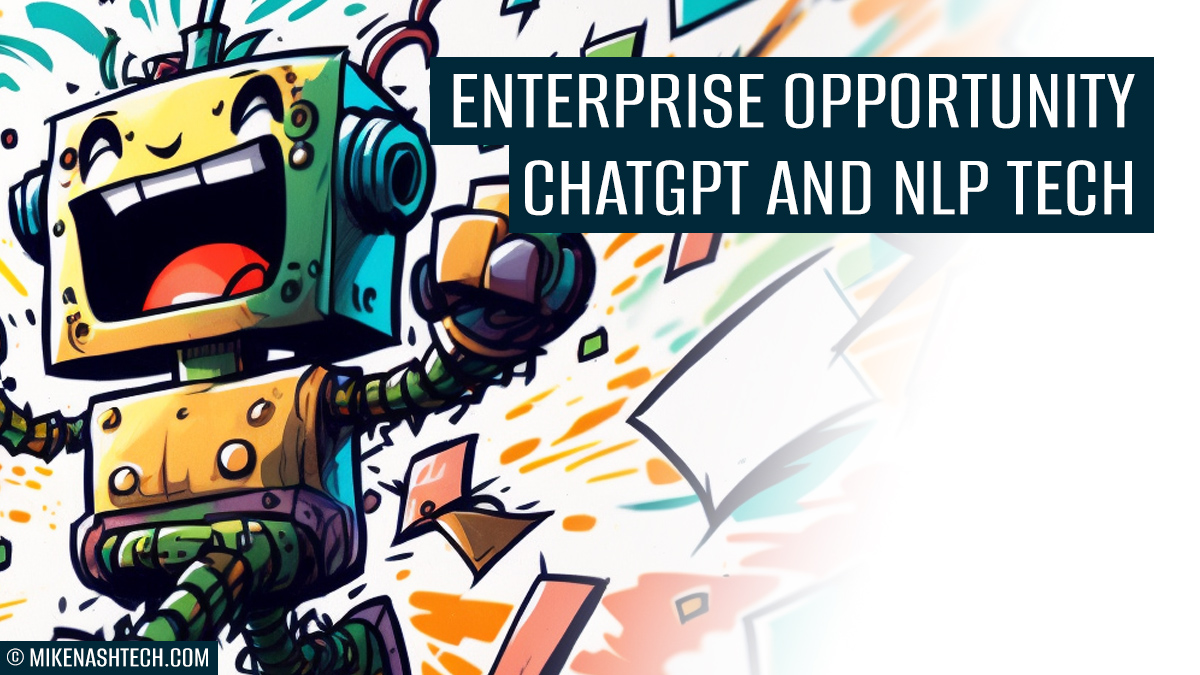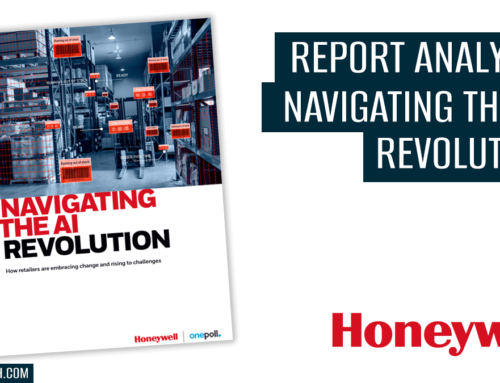Wednesday, 8 February, 2023
Enterprise opportunity of ChatGPT and NLP technology
5 Min read
Key points
- ChatGPT – 1 Million users in 5 days
- ChatGPT – Human-like conversation
- ChatGPT – New uses found daily
- NLP – Affordable, versatile and scaleable
- NLP – Applicable for all aspects of business
- Have a solid NLP strategy
It is hard not to notice the ChatGTP tidal wave that has hit the world in the past few weeks. It reached one million users in just five days, according to Sam Altman, the OpenAI co-founder.
Many are touting that ChatGPT had an ‘iPhone moment’ when it launched, and its revolutionary touchscreen technology squashed all mobile opposition and changed the face of the mobile industry forever.
But what is ChatGPT, what technology is behind it, where did it come from, and how can technology like this help your business?
Why is ChatGPT so successful?
ChatGPT looks similar to Google, but with the advancement of giving direct answers to search queries rather than getting you to search from its advanced and world’s most extensive neural network. The USP of ChatGPT is that it empowers human-like conversations by learning from previous questions similar to a human-like discussion.
Scratching the surface
It’s becoming clear from the daily discoveries that we have scratched the surface of ChatGPT’s applications and possible capabilities. Already, there are thousands of uses for ChatGPT. The main ones include:
- Explaining complicated subjects.
- Composing, revising, or summarising written material.
- Solving complex arithmetic issues.
- Writing, debugging or explaining code.
- Translate quickly and easily.
Every day, users find new uses for this technology, individually or commercially.
Core reasons for ChatGPT success
Modern Natural Language Processing (NLP) and Natural Language Generation (NLG) techniques, which have significantly advanced in recent years, are the foundation of ChatGPT. These approaches enable the model to produce more human-like replies. Its success is down to the following:
- Large-scale training: ChatGPT model is trained on a vast quantity of textual information, enabling it to learn and comprehend a variety of subjects and languages. As a result, the model can respond to various requests with relevant and accurate information.
- User-friendly API: The ChatGPT OpenAI API is simple to use, making it available to various developers and companies. The model’s features can quickly and easily integrate into current systems and applications.
- Priced affordably: OpenAI provides the ChatGPT API at a competitive rate, making it available to small and big organisations.
- Versatility and adaptability: It is perfect for various applications, including lead generation, process automation, and customer support. Additionally, it is simple to adjust and alter to fit unique corporate requirements.
NLP goes back, way back
Built on powerful, well-established GPT3 technology, ChatGPT is one of the most significant language models with over 175 billion parameters. Similar systems and ML platforms are available for free or hire, but only some can match this power and size today. But the story of Natural Language Processing (NLP) goes back further.
1950’s
Researchers’ earliest attempts to use computers to process and analyse human language were in the 1950s when NLP research concentrated on creating computational models for comprehending language structure, such as syntax and grammar.
60’s – 70s
In the 1960s and 1970s, researchers started concentrating on developing machine translation techniques, which simply mechanically translate text from one language to another. New NLP methods, including text categorisation, information retrieval, and summarisation, were developed, opening up many possibilities for the future.
80’s – Today
The focus of NLP research changed in the 1980s and 1990s to the development of increasingly complex approaches to interpreting linguistic meaning, such as discourse analysis and semantic analysis. The performance of NLP models was significantly enhanced in the 2000s and 2010s by developments in machine learning and deep learning, which sped up the growth and diversification of NLP applications. Many began using NLP in different sectors, including marketing, customer service, finance, and healthcare.
NLP has gone a long way since its inception, constantly evolving and improving as experts create novel methods and algorithms for parsing and comprehending human language.
Google has recently announced a new NLP called Bard. With new ones expected, it is undoubtedly transforming AI and opportunities for businesses and society.
Business’s best friend?
ChatGPT could be very beneficial for your firm in many ways. Systems that employ natural language processing (NLP) can completely change how organisations operate by automating operations that previously required human involvement and freeing up precious time and resources. NLP systems also provide numerous advantages that can have a significant effect on a business, like:
- Savings: Employing NLP systems may lower the cost of customer support and other jobs that often call for human involvement, making the technology a financially viable option for companies.
- Automation: NLP systems may automate repetitive operations like data input, appointment scheduling, and email management, freeing personnel to concentrate on more essential duties. This results in increased efficiency and productivity.
- Better customer support: NLP-powered chatbots may offer round-the-clock customer support, responding to commonly asked questions, taking care of client inquiries, and pointing consumers in the right direction.
- Better data analysis: NLP systems can glean insightful knowledge from voluminous unstructured data, including comments left by clients, posts on social media, and survey replies, enabling companies to make data-driven choices.
- Personalisation: Natural language interactions with users are one way NLP systems may improve user experience and foster closer connections with clients.
Overall, NLP systems are transforming businesses by offering numerous benefits, many of which we have yet to see.
What should you consider for NLP?
The first thing to do is consider why you need NLP, what it is trying to solve, and, more importantly, what value it will bring to your business. Try and measure the rewards and costs of using NLP in your organisation. When you are happy, you can start looking at a comprehensive process:
- Define the problem and the goals: Clearly state the issue you’re attempting to resolve and your plans for the NLP project. Align with the business strategy with a clear idea of the returned value.
- Gather data: Compile and prepare the data required for the project. Text data and any other pertinent information should include in this.
- Exploratory Data Analysis: Examine the data to understand its patterns, trends, and relationships.
- Choose tech: Choose to either use technology like ChatGPT or develop in-house. ChatGTP has an API that can easily bolt into existing architecture.
- Refine tech: Extract relevant features from the data utilised to train the model using feature engineering.
- Model selection: Select a suitable NLP model based on the problem’s characteristics and the data. Deep learning models like RNN, LSTM, and Transformers for NLP issues.
- Evaluation: Evaluate the model using the training data and the correct assessment measures. Here, the model begins to develop the ability to anticipate outcomes based on the input data.
- Launch: Once optimised, put the model into service in an appropriate environment. It should interact seamlessly with any existing systems and be scalable as necessary.
- Monitoring and upkeep: Keep an eye on the performance of the deployed model and make any required adjustments.
The future is all about NLP.
NLP, like ChatGTP applications, have many applications and potential for enterprises of all levels. However, their success depends on whether they solve a specific problem or offer value to your organisation. Whatever NLP you choose, consider developing a sound strategic plan. There is no better time to add value, reduce costs and create new opportunities to grow further and faster.
Contact me today to see how I can help your business get the most out of NLP.
Key stats
- $29 Billion on OpenAI after ChatGPT
- Over 300 Million monthly visitors to the OpenAI website
- ChatGPT to Hit $200 Million Revenue Goal by 2023
- World’s largest Neural Network Powering ChatGPT
More information
Please note
I have no affiliation with the companies/technology/people mentioned. This analysis is 100% independent for the benefit of the data/business community. Please feel free to share this on your social network. Thank you.
Feel free to contact me today
I can give you the best out of AI by:
- Spotting the latest AI opportunities for your company
- Pinpointing the best AI experts for your project or company
- Giving the best advice on AI strategy and approach
- Helping extract the most value out of AI
- …and lots more, please feel free to contact me today




